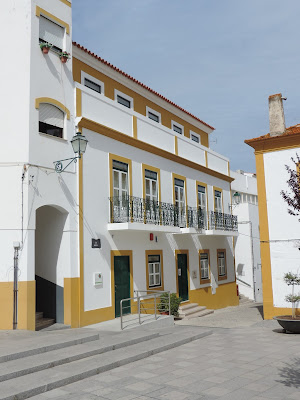Finally at
2:45 pm, we left the southern coast and drove inland on a road near the border
to Spain. This part of Portugal is mountainous.
We did see some pine forest agriculture, but the villages were far apart and
the area sparsely populated. We stopped
at the village of Alcoutim which is located in Portugal, just across the river
from Spain. We climbed to the top of the castle where we had great views of the
river valley which is the border between Spain & Portugal. This castle was
used as defensive force centuries ago.
 |
| Flowers along the road |
 |
| Alcoutim |
 |
| Spain across the River |
We are needing to wander our way back toward Lisbon so we are there by early tomorrow afternoon, so we went toward Mertola. Here again we climbed to the top of the castle walls. These castles are all setting at the top of the highest hill in the area. Many times we talk about how these places were built, in the years they were built – with no modern equipment! It is unbelievable.
 |
| Mertola Castle |
 |
| Castle Wall |
 |
| River from the Castle |
 |
| Mertola Town from the Castle |
 |
| Mertola Parish of St Mary Among Vineyards |


Along the
way the past several days, we have seen storks – lots of storks. The young are
hatched and large enough that you can usually see their heads sticking out of
the large nest. In one location this
afternoon we saw at least 25 nests.
Tonight we Googled regarding Storks so we could learn more about them –
such as, what do they eat? The farmers
love them as they eat bugs, beetles and pest that attach crops. The farmers use
less pesticides due to having storks near their crops. Storks also like the marsh areas as they eat
small fish, frogs and small snakes. Storks mate for life, and return to the
same nest. Often the young return to the
same area as their parents and make a nest near to where they were born. It is
not unusual for there to be 3-4 nests on the same building. They also build on top of electric poles –
not sure how they balance that large nest. At one place we saw a series of 10
poles, each having a nest, then one pole may be missed, and there is another
series of nests. Storks bring you good luck. Actually it is a crime to kill a stork or
disturb a nest in Portugal.
 |
| Flowers among Cork Oak Trees |
 |
| Wheat among Cork Oak Trees |
 |
| Yellow Flowers among Cork Oak Trees |
 |
| Stork Nest on top of Power Line P;oes |
We also
Googled about cork. We have seen young
groves of cork, and wondered at what point they begin harvesting – they like
the tree to be 2 ft in diameter, which is usually about 30 years old. As I said earlier they do not harvest cork
more than every 9 years, but it can be longer than that – it depends on how
fast the tree develops it cork bark. Cork Oak tree usually live to be 300 years
old. Google if you want to learn more about the process of harvesting and
processing cork.
Later this
afternoon, after we were north of the mountains, but still in rolling hills, we
began seeing more groves of olive trees, large vineyards of grapes, and huge
fields of wheat.



















































No comments:
Post a Comment